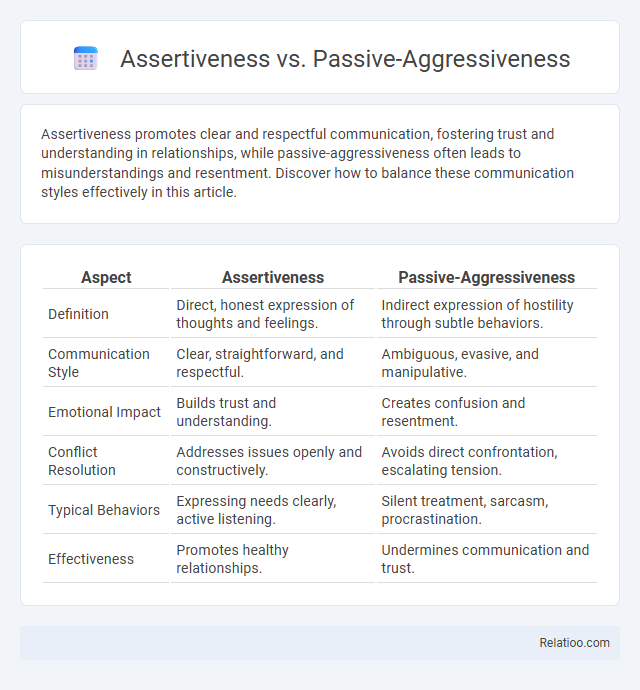Assertiveness promotes clear and respectful communication, fostering trust and understanding in relationships, while passive-aggressiveness often leads to misunderstandings and resentment. Discover how to balance these communication styles effectively in this article.
Table of Comparison
| Aspect | Assertiveness | Passive-Aggressiveness |
|---|---|---|
| Definition | Direct, honest expression of thoughts and feelings. | Indirect expression of hostility through subtle behaviors. |
| Communication Style | Clear, straightforward, and respectful. | Ambiguous, evasive, and manipulative. |
| Emotional Impact | Builds trust and understanding. | Creates confusion and resentment. |
| Conflict Resolution | Addresses issues openly and constructively. | Avoids direct confrontation, escalating tension. |
| Typical Behaviors | Expressing needs clearly, active listening. | Silent treatment, sarcasm, procrastination. |
| Effectiveness | Promotes healthy relationships. | Undermines communication and trust. |
Understanding Assertiveness: Key Traits and Benefits
Assertiveness involves expressing Your thoughts and feelings clearly and respectfully, balancing confidence with empathy to maintain healthy communication. Key traits include directness, self-assurance, and the ability to set boundaries without infringing on others' rights. Embracing assertiveness enhances personal and professional relationships by fostering trust, reducing conflict, and promoting mutual respect.
Defining Passive-Aggressiveness: Hidden Behaviors Explained
Passive-aggressiveness involves indirect resistance and covert expressions of negative feelings, often through procrastination, sarcasm, or subtle sabotage. Unlike assertiveness, which clearly communicates your needs and boundaries respectfully, passive-aggressiveness hides true emotions behind ambiguous or contradictory actions. Recognizing these hidden behaviors allows you to address conflicts openly and improve interpersonal communication.
Core Differences Between Assertiveness and Passive-Aggressiveness
Assertiveness involves expressing thoughts and feelings openly and respectfully, valuing both personal rights and others' perspectives. Passive-aggressiveness, by contrast, hides true feelings behind indirect behavior, often leading to misunderstandings and unresolved conflicts. Core differences include clarity in communication, respectfulness, and the willingness to address issues directly versus evading confrontation through subtle resistance.
The Psychology Behind Assertive Communication
Assertive communication reflects clarity and confidence, enabling individuals to express their thoughts and needs directly while respecting others, which promotes healthy interpersonal relationships and psychological well-being. Passive-aggressive behavior, characterized by indirect resistance and avoidance of open dialogue, often stems from fear of confrontation or low self-esteem, leading to miscommunication and emotional tension. Understanding the psychology behind assertiveness reveals its role in fostering self-respect and reducing anxiety by encouraging honest, constructive exchanges that prevent the buildup of resentment and frustration.
Recognizing Signs of Passive-Aggressive Actions
Passive-aggressive actions often manifest as indirect resistance, sarcasm, or subtle undermining, contrasting with the clear and direct communication characteristic of assertiveness. Recognizing signs like procrastination, backhanded compliments, and silent treatment helps distinguish passive-aggressiveness from assertiveness. Understanding these behavioral patterns enables effective conflict resolution and healthier interpersonal communication.
Impact of Assertiveness on Relationships and Well-being
Assertiveness fosters clear communication and mutual respect, enhancing relationship satisfaction and emotional well-being by reducing misunderstandings and internal stress. Passive-aggressiveness, in contrast, often leads to resentment, damaged trust, and increased anxiety, negatively impacting interpersonal connections and mental health. Prioritizing assertiveness promotes healthier boundaries and more effective conflict resolution, contributing to overall psychological resilience and positive social interactions.
Consequences of Passive-Aggressive Communication Styles
Passive-aggressive communication often leads to misunderstandings, decreased trust, and unresolved conflicts in personal and professional relationships. Unlike assertive communication, which promotes clarity and mutual respect, passive-aggressiveness fosters resentment and indirect hostility. Consistent use of passive-aggressive behaviors can result in damaged relationships, lower team morale, and increased stress levels for all parties involved.
Strategies to Develop Assertiveness Skills
Developing assertiveness skills involves clear communication, setting boundaries, and expressing needs confidently without aggression. Techniques such as using "I" statements, practicing active listening, and role-playing scenarios enhance self-expression while respecting others. Contrastingly, passive-aggressiveness undermines relationships by indirect communication, making assertiveness essential for healthy interactions and conflict resolution.
Overcoming Passive-Aggressive Tendencies Effectively
Overcoming passive-aggressive tendencies effectively involves recognizing the subtle expressions of anger or resentment masked by indirect communication, allowing you to replace these behaviors with clear, direct assertiveness that respects both your own needs and those of others. Developing assertiveness skills enhances your ability to express feelings and boundaries confidently without hostility or avoidance, promoting healthier relationships and reducing misunderstandings. Consistent practice of these communication techniques empowers you to break the cycle of passive-aggressiveness and foster open, honest dialogue.
Building Healthy Boundaries: Assertiveness for Positive Change
Building healthy boundaries relies on assertiveness, which involves clearly expressing needs and limits while respecting others' rights to foster mutual understanding and trust. Passive-aggressiveness undermines boundary-setting by communicating hostility indirectly, causing confusion and eroding relationships. Developing assertive communication skills promotes positive change through honest dialogue, emotional regulation, and proactive conflict resolution.

Infographic: Assertiveness vs Passive-Aggressiveness
 relatioo.com
relatioo.com